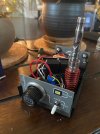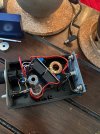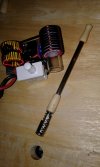@tokenknifeguy - interesting fact about induction heaters - there are two tuning parameters; ingress depth and power.
Ingress depth, the centering of the magnetic field, has everything to do with the clicker delay. The further the clicker is away from the center of the magnetic field, the center of the coil, the longer it takes to click. This means more heat of course, same as the 'extra second', but you can dial it in. In fact, the smaller the coil, the more sensitive this setting is. The best baseline for a new IH is to place the flat of the DV cap flush with bottom of the coil. Adjust from there. 3/4" coils are very forgiving where 15mm coils change their delay drastically with 1/2 millimeter moves.
The power level is how hot it bakes. You want a 4 second bake, sure HOTTER-N-HELL it is. 100 watts and just try to get that clicker to catch up before it combusts on the walls of the tip. That's the cost of speed - and some love that! Combustion, so what? No me - I hate combustion! I have learned 60-70 watts makes for a wonderful bake. A big open coil help make sure the tuning is simple and the power levels will be reasonable.
Once you get past the ingress tuning, you are about done. Every tip you have will function approximately the same with this setting. Same heat so to speak. Tips don't matter, this is merely preference. Remember, we're not after speed - we're after quality of the bake. Toast smells great - burn toast, not so much. Both are eatable.
The power parameter is what bites most DIY projects in the ass. Induction heaters are analog devices. They function based on the power given. In simple way, they translate voltage. The induction heater takes DC voltage and converts it to an AC voltage. The AC voltage is pushed into the coil making for an electromagnet. This part is simply what we are dealing with. Delivering the desired amount of 'power' is the can of worms that drives DIY on its head.
For desktop units, you have a known quantity. You will only be providing one voltage, typically 12VDC. You can read the current this draws to get a decent idea of what the wattage of your heater is with -that- cap. Every cap you have will have a different reading - some close to the same and other not. Say the unit draw no more that 5 amps with all of your caps. That is a 60 watt heater for your collection. For my collection, that would be a 50-70 watt heater. The actual voltage at the module itself will tell you exactly what is going on. Many IH are under-powered and the power supply is woefully under-rated. Knowing these parameters is a good thing to know.
Battery power adds a couple of new challenges. Consider the above - the power will change throughout the 9-12.6V range of the battery pack. That could mean the difference between a 60 watts heater we had at 12V and 35W paperweight at 9V. You want that entire battery pack's range down to 9V to be that 60 watts if not at least 45 watts. You need an acceptable target, but don't overlook it either. Each cap should love the setting from a fresh charge to the 9V cutoff of the BMS. Now you see the reason for tightening up performance throughout the voltage range.
But wait, there's more crap in the way! Cells have internal resistance. This has to be thrown in with the mix. We have high current devices. The least current you will draw is around 4 amps at low voltage. The cells are specifically depleted when they hit 9V when firing, they are being drawn down to that voltage due to the power being drawn through this virtual resistor known as internal resistance. So the cells will recover to some higher value at rest. Minimizing this effect to achieve the best battery performance is a real dance.
How does this flow from my fingertips so easily? This -is- my C'19 motivational studies. I have a history with induction heating and this makes it fun. Also know that I've been balancing these parameters for the new Fluxer Heaters Flite IH. Between what Orion was able to achieve with 1000mah cells and what I'm getting from the Flite with 1200mah cells, I am a firm believer that optimization on battery devices is very useful.
A little more information while we are here;
Magnetic Coupling has a ratio; firing current over idle current. I get a range from 6.2:1 down to 3.6:1 from different caps.
Any cap can produce vape at 150mah of energy imparted on the cap. '150mah to the click on an efficient IH' Back calculate Orion and you will get close to that figure. I get nearly 11WH from 3S 18350 1200mah cells.
These may not all have solutions but I've taken a lot of data to come up with the best compromise. Just because one cap makes everything line up, another cap could just knock down your house of cards. I have a wide range of caps now. And I have a perfect heater for me in the Fluxer Flite for all my caps. Not shilling here, honest. I had a little input with regard things discussed here. I am very happy with the results.





